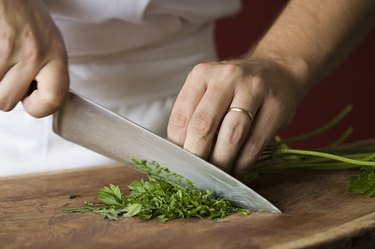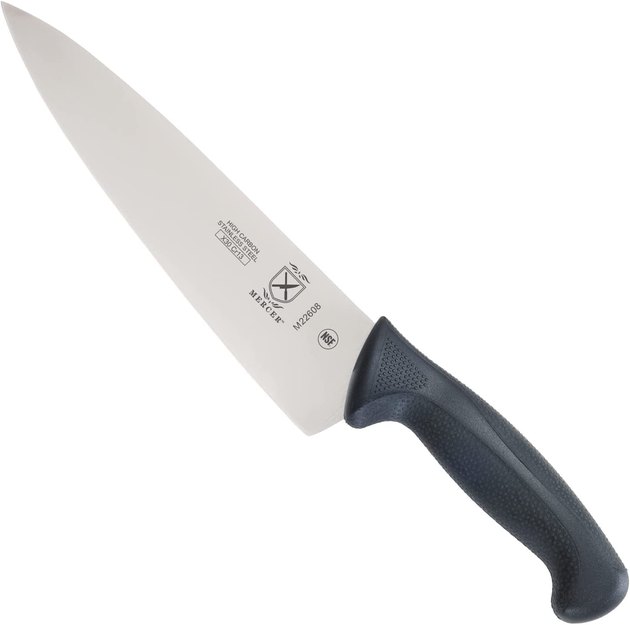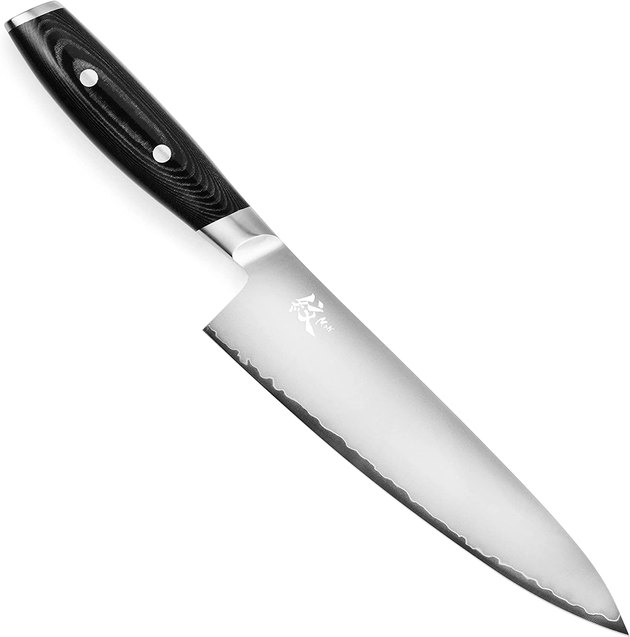
There aren't many tools in your kitchen you'll use more than your chef's knife if you work with fresh ingredients at all. It's the most versatile knife in your collection: You'll use it to cut, slice, chop and occasionally—on the biggest and toughest fruits and vegetables—even peel. Buying the best knife you can budget for is a no-brainer: You'll use it every day, and a good one will make everything you do just that much easier.
So what sets the best chef's knives apart from the rest? There is a range of factors, including the blade's size and shape, the style of handle and its balance. So sit down, buckle up, and we'll explain why we think these are your best choices.
Video of the Day
Video of the Day
What to Consider When Purchasing a Chef's Knife
There are some things no written description can tell you about a chef's knife, like how it will feel in your hand. That's important, but there are plenty of other characteristics you can glean from a product listing. One is the length of the blade: Professionals often use a chef's knife with a blade that's 10 inches or longer, but for home use, an 8-inch blade is usually easier to handle.
Aside from that, a few points to look at include:
Material: The blade is the most important part, of course. Some knives use softer steel that sharpens easily, while others use harder steel that holds an edge for longer but is difficult to sharpen. Some kinds of steel rust easily and must be pampered, others are dishwasher-safe. Similarly, the handle materials matter. Wood is beautiful but slippery when wet, and can deteriorate if not cared for. All-metal handles are excellent for sanitation purposes, but—again—can be slippery. Plastics can be slippery and brittle or textured and durable. Practicality should be your main consideration, but aesthetics can definitely play a part as well. It's your kitchen, and the things you put in it should please you.
Japanese or European: German-style knives (Henckels, Wüsthof) have thicker, heavier blades that are sharpened to a wedge-shaped edge (traditionally at a 20-degree angle). Japanese-style knives (Shun, Mac, Global) use thinner, harder steel that's sharpened to a finer edge (typically 15 degrees or less). That makes the Japanese knives lighter, nimbler and sharper, but that thin, hard steel is also prone to chipping. They'll give you a beautiful cutting experience, but they're higher maintenance compared to the durable, workmanlike European style. Both are good, it's just a question of how much care you're willing to give your knives.
Maintenance Requirements: That brings us to another key consideration, the kind (and degree) of care a knife requires. Almost all knives benefit from hand-washing, but some—with rust-resistant blades and utilitarian handles—are fine with getting tossed into the dishwasher. Others require hand-washing and immediate drying to preserve their steel. Similarly, wooden handles usually need careful maintenance and perhaps even occasional oiling. Then there's the question of sharpening, whether you opt for professional sharpening or do it yourself with a good sharpener. Don't commit to a knife that requires more care than you can give it: Even the best chef's knife won't perform as it should if it isn't well maintained.
Bolster: Few things divide knife aficionados like a bolster. That's the name of the thick part you'll see where the blade meets the handle. In practical terms, it helps protect your fingers and stiffens the blade. It's also sometimes perceived as an indicator of quality because you'll only see it on forged blades (cheaper blades are stamped from a sheet of steel). That's not necessarily so: Some very workmanlike knives are stamped, and some very mediocre knives are forged, and few Japanese blades have one. More importantly, that thick bolster can make it difficult to sharpen a blade along its entire length (you'll get a blunt spot near the bolster). Ultimately it comes down to personal preference, so this shouldn't make or break your decision.

The Best Overall Chef's Knife
German-style knives are the utilitarian workhorses of the professional cooking world and for good reason. They're versatile, they're durable, and they're relatively easy to sharpen and maintain. If you've got the budget for it, you definitely can't go wrong with Wüsthof's Classic Ikon chef's knife. It's a classic all-rounder, sharp enough to tackle the most delicate work but still heavy enough and durable enough for crunching through chicken bones or dense vegetables. The iconic manufacturer (still family-owned) uses its own high-carbon alloy to make the blades, and—like the Japanese—sharpens them to a finer angle than you'd get with Henckels or other rivals. The Ikon series has a contoured grip, superb balance and a half-bolster (it protects your fingers, but doesn't interfere with sharpening). If you prefer a more classic design and a full bolster, the Wüsthof Classic is an equally good option.
The Best Value Chef's Knife
A lot of professionals start their careers with this exact knife, a utilitarian tool for working kitchens. The steel on these blades is relatively soft, so you'll need to touch it up frequently, but that's not necessarily a bad thing: They're easy to sharpen, so it won't take you long but it will teach you sharpening skills that you can apply to higher-end knives as you upgrade. The handle is textured and easy to grip and forms a finger guard to serve the protective purpose that a bolster does on other knives. The only shortcoming of this knife is that hand-washing is recommended. If you want something that's explicitly dishwasher-safe and are willing to pay a higher (but still modest) price, the Victorinox Fibrox chef's knife is very similar and has slightly better steel.
The Best Chef's Knife for Small Hands
If you have small hands, or just find that a small handle feels better in your grip, Global has a knife for you. The high-profile Japanese manufacturer makes distinctive all-steel knives, which means the handle can never separate from the blade (and the lack of seams and crevices is great for food safety). The extra-strong steel—an alloy with chromium, molybdenum and vanadium—holds an edge for a remarkably long time, and the knives are remarkably lightweight. A 7-inch blade remains large enough for most kitchen tasks, but if you'd prefer to stick with an 8-inch blade those are available too and are also pretty suitable for small hands.
The Best Japanese Chef's Knife
The Japanese don't have a tradition of all-purpose chef's knives; historically they've used special-purpose knives for individual tasks. That being said, they've gotten very good at making them (a "gyutou" is the Japanese version of a Western-style chef's knife) and this example, from Mac Knife, offers outstanding value. Mac famously produces exceptionally sharp knives with thin and lightweight blades, and this "Mac Mighty" is true to that heritage. You'll glide through the ripest of tomatoes without effort, but it's still beefy enough and sturdy enough to cut through tough meats and gristle as well. The blade also has a so-called Granton edge, meaning the sides of the blade have dimples ground in that help keep meats, cheeses and other "clingy" foods from sticking to the blade.
The Best Value Japanese Chef's Knife
This isn't as visually impressive as some Japanese knives, but Yaxell is a very capable manufacturer and this gyotou punches well above its weight. The thin blade is made from an alloy very similar to Global's—a hard and stainless steel that's a bit more resistant to chipping than what you'd find with most Japanese knives. That's important because the blade is sharpened to a very fine angle (just 12 degrees). If you haven't used Japanese knives before you'll be shocked at how smoothly the lightweight blade cuts through just about anything. The handle is a durable resin-and-linen blend, securely riveted to the handle. Whether you think of this as the foundation for a larger collection, or a modestly-priced opportunity to dip your toe into the world of Japanese knives, it's a solid investment at the price.
The Best High-End Chef's Knife
Master bladesmith Bob Kramer's high-end, handmade knives made him a legend in the field. Unfortunately, individually hand-forged knives are time-consuming to make, and there was no way for Kramer—as a single craftsman—to meet the demand for his product. So he struck a deal with German manufacturer Henckels, and the company now makes multiple lines of Kramer-designed knives under its Zwilling brand. It's a stunning knife, blending the best of Japanese and German technology into one compelling hybrid. The beautiful Damascene cladding on the sides of the blade isn't just for looks (though it's striking), but protects the inner steel that provides the blade's cutting edge. The knives will take a razor edge, and Kramer's design yielded a lightweight and well-balanced tool that will last you for decades.







